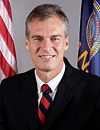Kansas
Gov. Thomas Andrew Osborn
- January 13, 1873 - January 8, 1877
- Republican
- October 26, 1836
- February 4, 1898
- Pennsylvania
- Married Julia Delahay; one child
- Ambassador
About
THOMAS ANDREW OSBORN, the sixth governor of Kansas, was born near Meadville, Pennsylvania on October 26, 1836. His early education was attained in the Pennsylvania public school system. He later learned the printing trade, which helped paid his way through Allegheny College. Osborn studied law, was admitted to the bar in 1857, and then established his legal career in Elwood, Kansas. He entered politics in 1859, serving as a member and president of the Kansas State Senate, a position he held until 1863. He also served as lieutenant governor of Kansas from 1863 to 1865, and was appointed the U.S. Marshall of Kansas, a post he held from 1865 until 1867, when he was removed for disagreeing with the policies of President Johnson. Osborn won the 1872 Republican gubernatorial nomination, and was sworn into the governorship on January 13, 1873. He was reelected to a second term in 1874. During his tenure, he dealt with three critical issues that monopolized most of his administration. The first event was the grasshopper infestation, which destroyed all of the state’s crops in the summer of 1874, causing famine across the state. Legislation was sanctioned that allowed local governments to minister in the aid and relief of those suffering from the grasshopper plague. The other two issues he dealt with were the Indian disturbances that erupted after a Cheyenne chief’s son was killed, and a scandal that developed in the state treasurer’s office. Also, a new state board of education was authorized, a state hospital in Topeka was planned, mortgages were made tax exempt, and changes were made to the state constitution that included four-year terms for senators, two-year terms for representatives, and biennial legislative sessions. After his gubernatorial term, Osborn ran unsuccessfully for the U.S. Senate in 1877. He served as U.S. Minister to Chile from 1877 to 1881, and was the U.S. Minister to Brazil from 1881 to 1886, earning a Grand Cross of the Order of the Rose for his special services. He also presided over the Kansas delegation at the 1888 National Republican Convention, and was a member of the Kansas State Senate from 1889 to 1897. Governor Thomas A. Osborn died on February 4, 1898, and was buried at the Topeka Cemetery.
Source
Sobel, Robert, and John Raimo, eds. Biographical Directory of the Governors of the United States, 1789-1978, Vol. 2, Westport, Conn.; Meckler Books, 1978. 4 vols.







